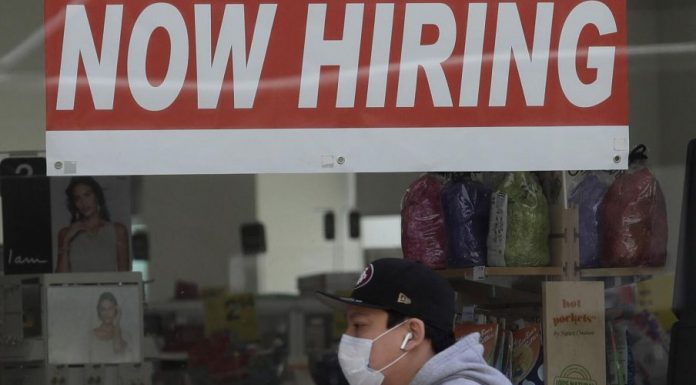() States that ended pandemic unemployment aid saw “a substantial rise” in employment, according to a recent working paper from the Federal Reserve Bank of St. Louis.
The study, which used data from 46 states and Washington, D.C., found that “in the three months following a state’s [emergency unemployment benefits] termination, employment increased by about 37 people for every 100-person reduction in EUB recipients.”
“The act of halting by a state was—on average—associated with a substantial rise in employment and a substantial decline in the number of unemployment insurance recipients relative to the other months,” the paper’s authors concluded.
During the pandemic, federal and state governments created unemployment insurance programs that were designed to provide stimulus payments to people who lost their jobs, working hours, or other sources of income.
The program provided weekly payments of $600 during most of 2020, although it was subsequently reduced to $300 per week in 2021.
As the payments were reduced, the program was also expanded to include contract, self-employed, and gig workers who were not eligible to receive the $600 per-week benefits.
According to the Fed’s study, many recipients saw “more than one-for-one replacement rate on lost earnings” whereas typical unemployment insurance payments were designed to replace between 40% and 50% of one’s typical earnings.
“The strong positive jobs effect that the data uncovered offers another basis for public policy discussions,” the study said.
The study comes as the latest job figures from the Bureau of Labor Statistics show that nonfarm payroll jobs increased by 528,000 in July while the national unemployment rate dropped to 3.5% from 3.6% in June.
BLS’s newly released economic data Tuesday showed the sharpest quarterly decline in labor productivity since 1948.
BLS reported a 4.6% decrease in labor productivity in the second quarter of this year as the economy shrank and labor costs rose. This data follows a decrease in productivity the first quarter of 2022 as well.
“From the same quarter a year ago, nonfarm business sector labor productivity decreased 2.5 percent, reflecting a 1.5-percent increase in output and a 4.1-percent increase in hours worked,” BLS said. “The 2.5-percent decline in labor productivity from the same quarter a year ago is the largest decline in this series, which begins in the first quarter of 1948.”
Labor costs have significantly increased in the past year.
“Unit labor costs in the nonfarm business sector increased 10.8 percent in the second quarter of 2022, reflecting a 5.7-percent increase in hourly compensation and a 4.6-percent decrease in productivity,” BLS said. “Unit labor costs increased 9.5 percent over the last four quarters.
This is the largest four-quarter increase in this measure since a 10.6-percent increase in the first quarter of 1982. BLS calculates unit labor costs as the ratio of hourly compensation to labor productivity. Increases in hourly compensation tend to increase unit labor costs and increases in productivity tend to reduce them.”
That spike in labor costs coincided with a decline in productivity.
“Labor productivity, or output per hour, is calculated by dividing an index of real output by an index of hours worked by all persons, including employees, proprietors, and unpaid family workers,” said the report.
“The second quarter of 2022 is the second consecutive quarter in which output decreased while hours increased,” it continued. “The resulting productivity declines over these two quarters reduced the average annual productivity growth rate since the fourth quarter of 2019 – the last quarter not affected by the COVID-19 pandemic—to 0.6 percent in the nonfarm business sector. Output and hours worked in the nonfarm business sector are now 2.9 percent and 1.5 percent above their fourth-quarter 2019 levels, respectively.”
Despite wage growth, those increases have not kept pace with inflation.
“Real hourly compensation, which takes into account changes in consumer prices, decreased 4.4 percent in the second quarter of 2022, which followed a 4.4-percent decline in the first quarter of 2022,” BLS said.
The data comes amid a national debate over the definition of a recession and whether the U.S. has entered one.
The White House has pointed to the labor market, particularly low unemployment, when arguing there is no recession. But this data shows that for the past two quarters, labor productivity has dropped.
Federal economic data from the Bureau of Economic Analysis in late July showed that U.S. gross domestic product decreased by 0.9% in the second quarter of this year. The BEA reported GDP shrank by 1.6% in the first quarter.
“The decrease in real GDP reflected decreases in private inventory investment, residential fixed investment, federal government spending, state and local government spending, and nonresidential fixed investment that were partly offset by increases in exports and personal consumption expenditures…” the BEA said.

